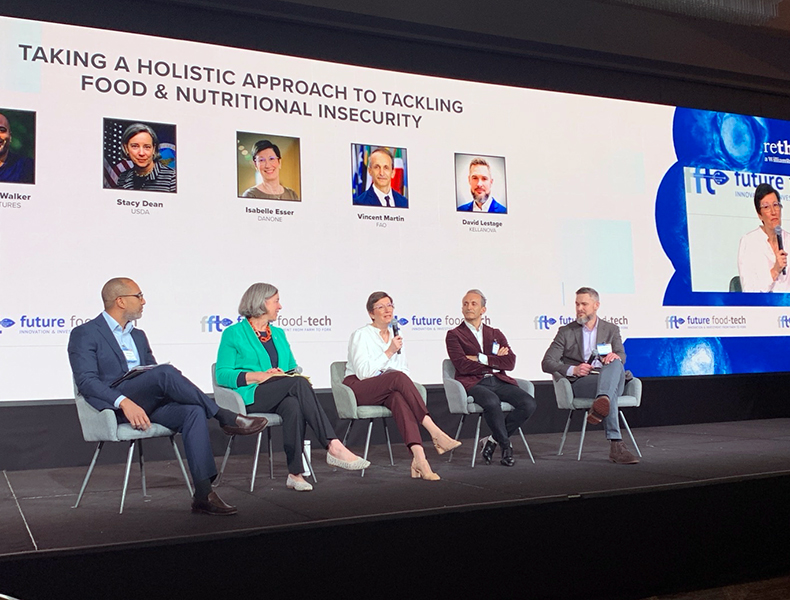Food Technology Magazine | Digital Exclusive
Future Food-Tech 2024 Tackles Transformation, Underscores Collaboration
Mission-driven Future Food-Tech exhibitors and conference presenters showcased innovative, transformative ingredients and technologies and emphasized the importance of collaboration in addressing food system challenges.

Future Food-Tech panelists discussed food and nutritional insecurity. Pictured, from left: Matthew Walker, S2G Ventures; Stacy Dean, U.S. Department of Agriculture; Isabelle Esser, Danone; Vincent Martin, FAO; and David Lestage, Kellanova.
While the obvious theme of the Future Food-Tech conference held in San Francisco March 21–22 is transformative innovation, another descriptor also comes to mind to convey the spirit of the conference—collaboration. Conference presenters and participants frequently referenced the importance of collaboration—both to address the food system challenges confronting the world and also to advance the cutting-edge technologies exhibitors and attendees at the event highlighted.
To reduce food and nutritional insecurity, both concepts must be prioritized, emphasized Isabelle Esser, chief research & innovation, quality, and food safety officer for Danone, in one of the conference’s opening sessions.
“Innovation is paramount to solve a lot of the problems that we have today in the world about food—food systems, food security, food accessibility—but also to create a thorough understanding of consumers and what they need and want—delicious and nutritious product,” Esser said. “But we can only do that through collaboration, and it’s collaboration through the ecosystem and collaboration through the value chain.”
Panelist David Lestage, chief R&D officer at Kellanova, concurred. “Partnership is key. Collaboration is key. No single entity or food company is going to solve this issue. We need to bring everyone to the table—consumers, policy makers, NGOs, startups, you name it, to create a shared vision … and a shared accountability to deliver it.”
Even startups in this space tend to operate with a collaborative mindset said Future Food-Tech attendee Thomas Cresswell, chief business officer with precision fermentation company Melt&Marble. “There’s some element of competition, but it’s always very friendly,” Cresswell said. “We have very open conversations.”
Much of that mindset stems, of course, from the fact that organizations in this space are mission-driven and committed to advancing sustainability, reducing the impact of food production on climate change, and feeding the growing global population more nutritiously.
Describing why she and others in the cultivated protein sector remain optimistic despite obstacles ranging from cost to consumer acceptance to regulatory roadblocks, Amy Chen, COO of UPSIDE Foods, had this to say: “There is no other option. The planet literally can’t sustain the way we are eating today.”
Here’s a look at just a small sampling of the trends, products, and topics that were in the spotlight at Future Food-Tech.
Alternative Fat Breakthroughs
Get ready for a new generation of plant-based products thanks to developments in the creation of alternatives to animal fats.
Australia-based Nourish Ingredients, which makes animal fat analogues using precision fermentation, unveiled its Creamilux lipid that, as its name suggests, delivers creamy texture and emulsification properties. Nourish Ingredients also offers a fat analogue it calls Tastilux.
Nourish Ingredients founder and CEO James Petrie, a former scientist with Australian scientific research agency CSIRO, left that organization with a goal of building on work he’d done there to create non-animal fats capable of improving the taste and mouthfeel of plant protein products. He explained that the company’s technology provides a high-quality fat animal fat substitute because it focuses on the specific fat molecules that are most responsible for animal fat’s taste.
Sweden-based Melt&Marble also uses precision fermentation to create meat-like fat alternatives, explained Cresswell. He said the company’s designer fats have applications in the alternative protein, personal care products, and specialized nutrition markets.
The company’s fat alternatives have half the saturated fat of coconut oil, which is frequently used to fill in for animal fats in plant protein products, Cresswell said. It’s also free of cholesterol, trans fats, and hormones. He said that the company is working now on GRAS (generally recognized as safe) approval for its products.
Keeping it Positive
It’s time to shift the focus from nutritional no no’s to the healthful benefits foods and beverages can offer, presenters in a panel on developing products that are both healthful and indulgent emphasized.
“If you want to look at food holistically, you can’t just look at one aspect,” said Seth Crass, director of QA/R&D with prebiotic soda maker OLIPOP. “Rather than telling consumers they shouldn’t have that [soda], we’re trying to create a healthier alternative,” he said.
Crass emphasized the importance of creating products with bona fide nutritional benefits. “We can’t just sprinkle some fiber into [the product]” and call it healthful, he reflected.
Panelist Johanna Vazquez, head of R&D – North America Nutrition, Unilever, seconded the importance of that approach, noting that Unilever has a goal of doubling the amount of positive nutrition in the company’s products by 2025.
“What we want do,” she said, “is not only reduce nutrients of concern, which has been our approach over the past 20 years … but also add meaningful amounts of positive nutrients … into our products.”
Investor Commitment
Investment in startups plummeted last year, but that’s not the end of the story. Investors who participated in a panel discussion at Future Food-Tech said they remain committed to the category, but emphasized the importance of strong business plans and realistic valuation.
The connection between health and food consumption is increasingly understood and people are becoming more proactive about improving their diets, noted Steve Young, managing partner at private equity firm Manna Tree Partners. And this ensures that startups that offer such benefits are attractive investment options. “That’s why we at Manna Tree continue to say, ‘look, we’re going to deploy capital and partner with people like you [wellness-focused startups] to go and solve those problems,’” Young said.
“This reset that we’re having is in a way a good thing because it will create a better cycle starting today where the companies are more reasonable in the valuation rates and the right amount of capital,” said Sebastien Pascual, director, agri-food investment, for global investment firm Temasek. “And those returns will be faster because they won’t be staying private for the next 10 years.”
Market conditions have changed, acknowledged Ryan Shadrick Wilson, founder and CEO, Boardwalk Collective, an investment and advisory firm. “The macroeconomic environment is different,” she said. “It’s different than it was five years ago. It’s different than it was two years ago. But the macro trends for which many of these companies have been founded—to address a climate concern, to address the skyrocketing rate of diet-related chronic disease—those have not changed. And so yes, this year you might get 5x and not 10x on a company [valuation], but we’re still solving really big problems. And I don’t want to lose sight of that.”ft






